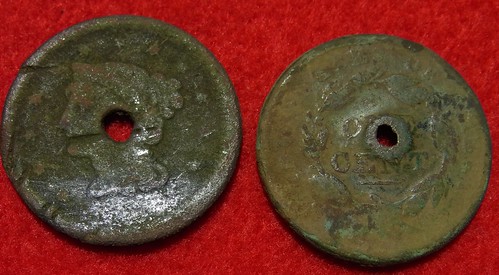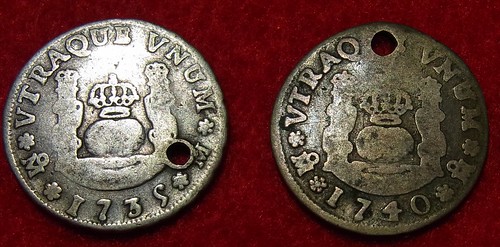
PREV ARTICLE
NEXT ARTICLE
FULL ISSUE
PREV FULL ISSUE
MORE ON HOLED SLAVE COINS
Last week we discussed an article from the Baltimore Sun mentioning a holed silver Spanish coin found in an archeological dig in Annapolis, MD. The purported reason for the hole is that it was worn to provide supernatural protection, and I asked if anyone could provide more information on the topic.
-Editor
Gene Brandenburg writes: Elvira Clain Stefanelli of the Smithsonian gave me a tour of their "holy of holies" one day and mentioned a forthcoming display she was planning - of "slave marriage coins" . Evidently small denomination silver coins (half dimes, dime or 1/2, 1 real coins) were holed and worn around the neck or on a wrist as an indication that the slave was married. I recall that when the Virginia side of the new Woodrow Wilson Bridge was being excavated, a 17th - 18th century slave burial ground was found near the river and a number of holed small silver coins were found. I believe that the burial ground was moved nearby, Current head of the National Numismatic Collection Dick Doty writes: We have some minor Spanish-American coins with holes, but I know of nothing Stefanelli was going to or ever did on the subject. It might have been before I came on board. I asked Tom Kays, who studies coin finds. He writes: Based on my study of old coins excavated in Virginia, on average about eight per cent of the older coins have holes. Almost all are holed near the rim. Coins holed at center are unusual to dig. I understand coins used in West African rituals to be holed at the center and buried at the corner of structures. The tradition served to help spirits who could recognize objects they possessed in life, to find their way back to visit their living relatives when taken away from familiar surroundings. Coins holed at the center also approximate the design of Chinese "cash." Later date coppers holed at center probably favor Chinese origins.

The holes in this enigmatic pair of dug large cents, "Braided Hair" obverse on left and the earlier style "Matron Head" reverse on right might have very different origins. Certain coins do carry special significance. Love tokens were popular in England, circa 1770, and in America, circa 1880. Coins holed at the rims would be secure to carry looped on a wire or thread. Tiny coins especially were easy to lose. If worn as adornments small silver might be carefully holed at the rim allowing them to dangle and jingle. It would be nice to think such coins served the function of wedding bands, but we must find contemporary references to "jumping the broom" that mention pierced coins to know for sure. The excavated coin mentioned in the article, but not pictured, may have been a Spanish silver half real of 1789. A "crude" piercing would tend to have been done for commercial purposes.


Similar to the reported find, these holed, half real coins of Mexico, dated 1788 and 1785, are pictured side-by-side. These coins were pierced from the reverse, long ago with excess metal on the downward side worn smooth. Always look for this wear on one side of the hole's rim to help validate the age of the piercing. Modern twist drills don't produce similar results. Another pair of well worn, one real coins of Mexico dated 1735 and 1740 with similar piercings. When describing piercings, consider a clock face oriented on the obverse such that the 1735 coin is holed at "4:00 o'clock" from the reverse while the 1740 is pierced at "12:00 o'clock" from the obverse.

One last pair of pierced, two bit coins are pictured. On left is an 1842 Republic of Mexico, Cap and Ray, two reales of San Luis Potosi, pierced at 2:00 o'clock and on right a 1795 Lima, Peru two reales with reverse slightly off-center, pierced at 12:00 o'clock.


Thanks for the info, everyone!
-Editor
To read the earlier E-Sylum article, see:
ANNAPOLIS COIN FIND: SUPERNATURAL PROTECTION?
(www.coinbooks.org/esylum_v14n25a16.html)
The Numismatic Bibliomania Society is a non-profit organization promoting numismatic literature. See our web site at coinbooks.org. To submit items for publication in The E-Sylum, write to the Editor at this address: whomren@gmail.com To subscribe go to: https://my.binhost.com/lists/listinfo/esylum All Rights Reserved. NBS Home Page Contact the NBS webmaster 
|